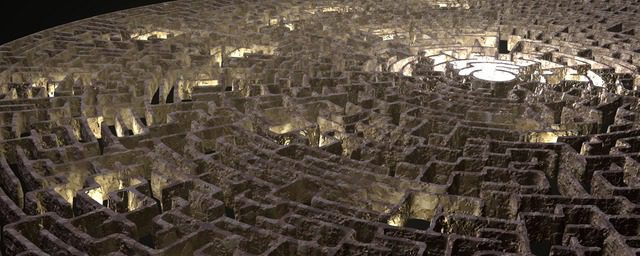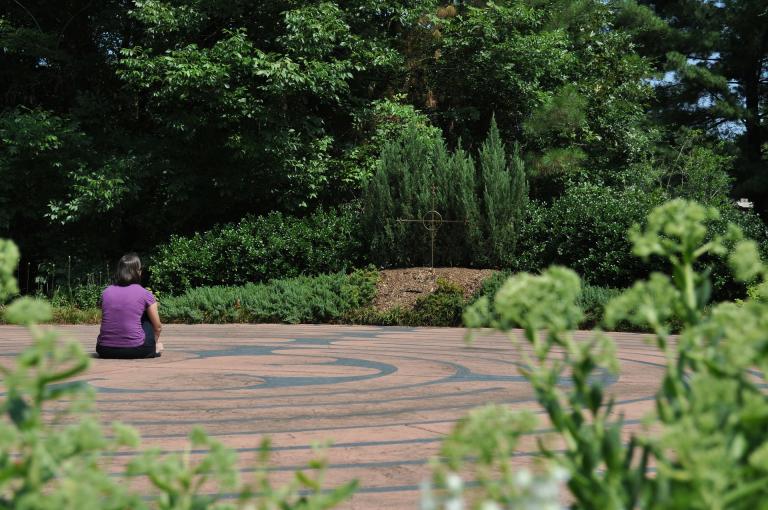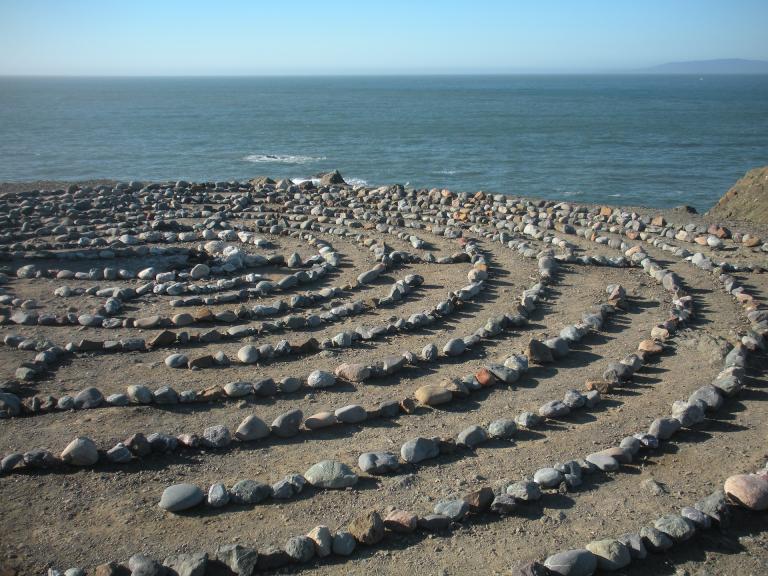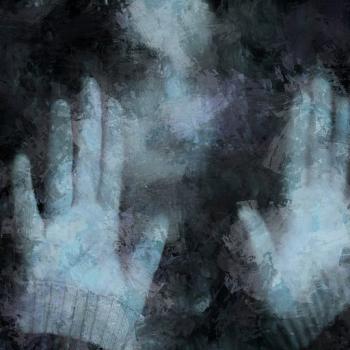This past weekend found my family and I broadcasting live from our 3 Pagans and a Cat YouTube Channel, teaching three classes, and moderating a discussion panel at Michigan Pagan Festival.
We had a wonderful time, but exhaustion, thy name is Gwyn!

The festival was four days of classes, rituals, and fun activities for everyone from children to adults. However, by Saturday morning I could feel the edges beginning to unravel, tension starting to creep in, just from having to “go, go, go” for so much of our time at MPF.
Taking time for quiet meditation or spiritual reflection became necessary self-care.
Thankfully, Renewal Coven was facilitating a labyrinth throughout the weekend.
If you are not too sure what a labyrinth is or what a person is supposed to do in one, please allow me to share some information, because until I walked through that labyrinth last weekend, I wasn’t so sure myself.
First, let’s define what a labyrinth is (and I do not mean the 1986 David Bowie film – God/dess rest his most excellent and beloved soul – nor the complex biological structure found within one’s ear):
A labyrinth combines the imagery of a circle and a spiral to form an irregular, meandering path toward a central location. And some of you may now be saying “Wait. Isn’t that just a maze?” The answer to your questions is yes and no.
“Laburinthos” is the root word of labyrinth.

In Greek mythology, we learn how Daedalus built a structure for King Minos of Crete at Knossos meant to hold a Minotaur. This building had winding, complex paths which branched off into various and opposite directions, multiple exits and entrances, as well as dead ends which could trap individuals inside. What Daedalus built was named a labyrinth in the Greek myth but its design and purpose better describe what modern scholars call a “maze.”
Therefore, a labyrinth is recognized as a single path which twists and spirals inward in a circuitous manner, leading toward the center, and which has only a single entrance/exit point.
Labyrinths have been appearing as designs or symbols in caves, on coins and pottery, as turf or stone structures from as early as the Stone or Bronze Ages. Many cultures throughout the world have traditions or stories which include labyrinths.
There are two styles of labyrinth.
Traditional labyrinths have the entrance/exit at the bottom, while the radial style show the entrance/exit at the top. Prehistoric or ancient labyrinths may have been used to trap evil spirits or been used in sacred dance and ritual. Roman labyrinths appear at the entrance of buildings which could have had a similar function of protection or been meant to symbolize a sacred path to deity.
Medieval Christian labyrinths appeared both in church entrances and on the sanctuary floors. Although their purpose is unclear, they could have been used in Easter rituals with penitents following the labyrinth on their knees or been designed as protection from demons. In India, there is a belief that labyrinths are the refuge of a trickster spirit and that the demon Ravana rules over labyrinths.

Mazes and labyrinths still hold fascination today.
The maze, because of its complexity, has become a popular attraction in the Autumn or Fall Season. You will often find them set up in small city parks and squares, constructed from towering bales of straw or hay, as part of the community celebration. The use of mazes, as an attraction, can extend into Halloween as “corn mazes” which can be scary when traversed at night or if “monsters” lurk in dead end corners.
Labyrinths have been maintained as a spiritual practice.
Individuals seeking spiritual connection can find a unique experience in a labyrinth. Walking the long, serpentine path toward the center allows a person to quiet their mind, focus on a spiritual question, engage in prayer, chant or meditation, ask a deity for guidance, or breathe and just be in the moment.
The labyrinth symbolizes spiritual wholeness.
To walk a labyrinth is to journey into your deepest self or the “other realm” and find what you need for spiritual connection, balance, healing, clarity, etc. The labyrinth journey isn’t for everyone. One must be able to step onto the path with an open, receptive mind and spirit, allowing intuition, feeling, creative visualization or imagery to take you on the journey. This is not always a comfortable experience but it can be a healing or deeply satisfying one.
While it’s unlikely for a person to become physically lost in a labyrinth, as a spiritual practice, those in a light trance or meditative state may find themselves overwhelmed, distressed, or feeling “lost” and unable to follow the path back out. Therefore, having someone stationed outside the entrance/exit, a person trained to retrieve whoever may be walking through, is a good precaution.

This is the role Renewal Coven members were performing while maintaining the labyrinth at MPF. As a person entered and walked through the spiral path toward its center and back, a Renewal Coven member would monitor the individual from the entrance, ready to come in and assist if needed or called. I found the presence of another to be a great comfort as I walked the labyrinth, an experience which was both calming and profound, as well as confirming where my path as a Witch is leading.
If you have the opportunity to walk a labyrinth, then I encourage you to do so, as long as you are emotionally and spiritually able to attempt the journey. There are no set rules or rituals you must follow but here are a few tips to follow:
- Stand at the entrance and breathe for a moment. Prepare your mind and spirit for the experience.
- Take small, measured steps, focusing your eyes a few feet ahead as you walk the path. Do not look anywhere other than in front of your feet, as the spiral pathway of a labyrinth can become disorienting.
- Do not rush. There is no time limit on your experience.
- Calm and clear your mind. Chant or pray if this is helpful for entering a meditative or trance-like state.
- Stop, if you need to, at any point on the path. Reflect on what you are feeling or sensing as you stand there.
- If you become confused or overwhelmed, just breathe. If you need to call out to the guardian-helper for assistance, then do so.
- Do not walk a labyrinth without a guardian-helper at the entrance, especially if it is your first time.
- Bring to mind a spiritual question as you walk or allow your mind to drift.
- Upon reaching the center, take the time to pause and reflect, pray, listen for an answer to your question or wait for a deeper revelation. You can also use this time to meditate, ground, and center if that is what you need.
- When you are ready to leave, follow the path step by step back to the entrance, allowing yourself to experience whatever the return journey brings to you.
- Once you’ve stepped out of the labyrinth, take some time to reflect on your experience. This is a good time to journal (if that’s a thing you do). Also, get something to eat or drink to bring yourself back to the here and now.


















